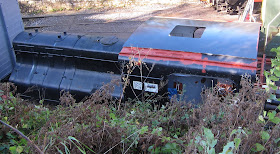 |
| Exhaust Condensate Valve |
Running across the white pipe is another pipe which links the two exhaust pipes and includes a valve for releasing the condensate. If the condensate is left in the exhaust pipes, it has to go somewhere so every time there is a decent chuff from the chimneys, there is an accompanying decent hot shower for anyone nearby! So it's a good idea to keep the exhaust dry.
As the condensate valve is underneath the water tank, it's not very accessible for the driver in the cab. So a remote control mechanism is required.
 |
| Restored Condensate Valve |
The top photo shows a wire cable going off upwards to the right that is used to operate the valve. It has to pass around a couple of pulleys to a friction-loaded operating handle.
 |
| Pulley and handle mounts darkened |
I'm having to remake one of the pulley mounts as the original has been lost; the other and the operating handle have now been restored.
 |
| Pulley (not rocket science!) |
 |
| The handle assembled with hardwood mounting block (1) |
 |
| The handle assembled with hardwood mounting block (2) |
In the above photo, there is a dark layer between the top of the base plate and the handle's cable drum. It is a friction pad made of either hardened leather or 1927-style plastic (which I guess would be Bakelite). There is a spring in the centre of the handle which holds the handle against the pad. For it to work effectively, the spring has to be tensioned correctly. I wonder if I've got it right? Time will tell.
 |
| Component parts |
 |
| DG Sentinel Waggon Parts Manual diagram |
It would be nice to be able to show the whole mechanism in place; however, it's not helpful to have a trip wire in the cab whilst there is still so much to do there! I'll include a final photo later.











































